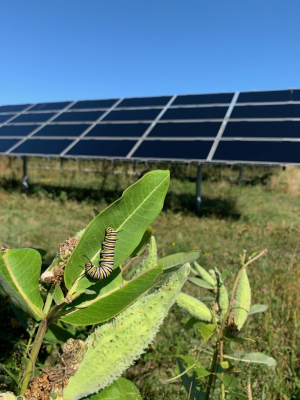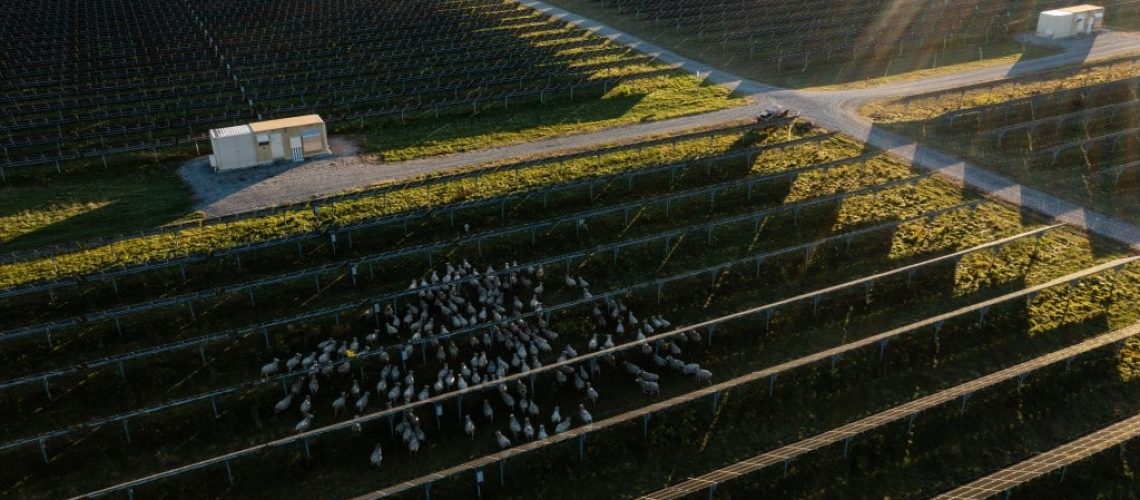EDF Renewables maintains a 23.4 MW agrivoltaic facility that supports local wildlife and agriculture. Since it was installed in 2009, the project pioneered efforts in supporting bees, butterflies, and sheep grazing.
June 6, 2022
There are many ways to build out the energy transition to renewables, and some are more sensitive to nature than others. Energy sprawl, or the increased use of land and water spaces to support energy infrastructure, could rise over the next several decades, working against some of the environmental goals that are the foundation of renewable energy deployment.
Distributed rooftop solar is one way to prevent energy sprawl, and another method, agrivoltaics, the co-location of farming and solar, can be effective in supporting local wildlife and farming practices while adding large amounts of emissions-free energy to the grid.
The AgriSolar Clearinghouse, an informational and networking organization dedicated to connecting farmers, landowners, and solar developers around the buildout of agrivoltaics, shared a case study of one solar farm that supported not just one species, but several. The study focused on the 23.4 MW Arnprior solar project in Ottawa, Canada, developed by EDF Renewables (EDFR). The project sits on 180 acres of land and can meet the peak energy demand of about 7,000 homes.
The pioneering project was built in 2009, at the time doubling the PV capacity of the entire country of Canada. Six years following construction, one of the landowners expressed interest to EDFR to return the land to functioning agricultural after decommissioning.
EDFR took interest in the idea, but decided not to wait for decommissioning to take action. In 2015 it began phasing out the use of pesticides and herbicides. By 2016, as declining bee populations became an international focus, it reached out to a local honey company to install hives at the site. Two hives were installed, and side by side with renewable energy, 100 jars of honey per year were produced. Today, efforts have expanded, and over 300 jars are made each year.

In 2017, EDFR received an award by the Government of Canada to provide a habitat for the monarch butterfly. Arnprior became the first solar project in Canada to be awarded by the Habitat Stewardship Program for Species at Risk. In tandem with the Pollinator Partnership, EDFR planted native wild flowers and milkweed, the exclusive host plant for monarch butterfly larvae. Within a month of the partnership, larvae and butterflies began to appear.
Later that year, the Arnprior site launched a pilot program for sheep grazing as a method of vegetation management to reduce shading on the solar modules. Local business Shady Creek Lamb Company brought 50 ewes to snack on vegetation and optimize solar production. The array site proved beneficial to the local sheep farmers, providing an area for the flock to expand without having to rent or buy additional land.

The arrangement offered the sheep farmers additional revenue streams, as they were paid for the sheep’s vegetation management services. In 2022, over 500 sheep roam the site from spring to fall, boosting production, eliminating the need for chemical-based plant killers, and providing free range lamb and fiber to the local market.
In total, the site has proved to be a win-win for both farmers and solar developers. This agrivoltaic model could prove useful for the energy transition. In California alone, Environment California said as much as 148,000 acres of land could be used to support solar by 2045, based on a state regulator estimated deployment of 28.5 GW. That is an area about half the size of Los Angeles. With this development comes the opportunity to build a future that is sensitive to all life on Earth and the farming needs of local communities.






